CIRP April 2016 eNewsletter
Recent Advances in Coastal Inlet Navigation and Adjacent Beach Research
Issue 37, April 2016
Dear Colleagues,
This message transmits the Coastal Inlets Research Program (CIRP) biannual email newsletter. The CIRP is a HQ Navigation and Operations Branch R&D Program with the mission of providing information and technology to reduce the cost of operation and maintenance of Federal coastal inlets, while treating the navigation project and adjacent beaches and estuary as a sediment-sharing system. This eNewsletter contains single paragraphs describing selected recent activities in the CIRP.
For feedback and suggestions on the newsletter, or for contributing a paragraph, please contact me.
For the CIRP investigators,
Julie Rosati
Julie.D.Rosati@usace.army.mil
CIRP Program Manager
In this Newsletter:
Coastal Modeling System (CMS)
CMS Calculations for Permeable Breakwater

Dr. Honghai Li attended the Coasts and Ports 2015 Conference and presented a research paper titled, “Littoral Hydrodynamics and Sediment Transport around a Semi-Permeable Breakwater,” in Auckland, New Zealand last fall. Dr. Li reported and discussed theory and application of the CMS with recent research advancements that calculate wave, current, and sediment transport through permeable structures, facilitating estimation of navigation channel shoaling that may occur with leaky jetties or breakwaters (Figure 1). The latest version of CMS can be downloaded from the CIRP website: http://cirp.usace.army.mil/products/cms.php; the conference presentation and paper are available here: http://cirp.usace.army.mil/pubs/conf_presentations.php.
POC: (ERDC) Honghai Li, Honghai.Li@usace.army.mil
POC: (ERDC) Chris Massey, Chris.Massey@usace.army.mil
POC: (ERDC) Mitch Brown, Mitchell.E.Brown@usace.army.mil
Improving Breach Modeling
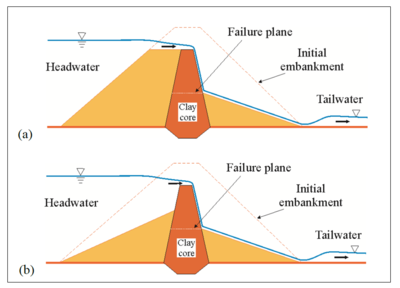
CIRP has several ongoing collaborations with universities to advance predictive technologies. Dr. Weiming Wu, Research Professor, Clarkson University visited CHL Vicksburg, 11-12 February. In response to Statement of Need SON-2014-N-14, CIRP and Clarkson University are conducting a joint study on “Implementation of Physically-Based Simulation Algorithms for USACE’s Next-Generation Dam/Levee/Barrier Breach Models,” see Figure 2. The purpose of the visit was to review the progress of the study and to discuss research objectives of next phases. During his visit, Dr. Wu presented a seminar “Simplified Physically-Based Modeling of Dam/Levee/Barrier Breaching.” He also met with research scientists and engineers from CHL and discussed potential future collaborations between CHL and the university. For more information about work on the new breaching models, contact the POC.
POC: (ERDC) Honghai Li, Honghai.Li@usace.army.mil
CMS Applications to Breakwater and Harbor Design
The CMS has recently been applied to evaluate implications of new structural designs and inlet and harbors, and three new studies are available for Faleasao Harbor, American Samoa; Tangier Island, VA; Kikiaola Harbor, HI; and Braddock Bay, NY: http://cirp.usace.army.mil/pubs/techreports.php . CIRP works with Districts in applications such as these to leverage funds, validate models and advance operation of CMS and Boussinesq modeling tools.
POC: (ERDC) Zeki Demirbilek, Zeki.Demirbilek@usace.army.mil
POC: (ERDC) Lihwa Lin, Lihwa.Lin@usace.army.mil
Inlets and Adjacent Beaches – Long-Term Morphology Change
Overview
CIRP has several research activities to address SONs concerning long-term morphology change of inlets, navigation channels, shoals, and adjacent beaches.
Design & Management of Coastal Dunes
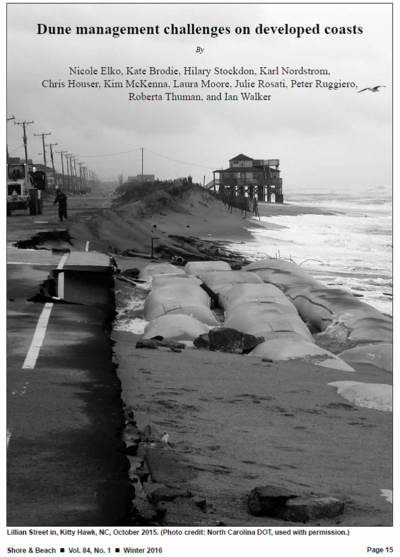
CIRP has been evaluating constructed and natural dunes to understand evolution of these morphologic features and improve guidance for dune design and maintenance. Recently, CIRP published “Coastal Foredunes: Identifying Coastal, Aeolian, and Management Interactions Driving Morphologic State Change,” which outlined a framework to identify the interplay between natural and anthropogenic processes and the resulting effect on the morphologic state, and ultimately resilience of coastal foredunes. http://cirp.usace.army.mil/pubs/techreports.php.
POC: (ERDC) Kate Brodie, Katherine.L.Brodie@usace.army.mil
POC: (ERDC) Nick Spore, Nicholas.J.Spore@usace.army.mil
Workshop on Coastal Dunes
CHL, in collaboration with the USGS, sponsored a meeting in Kitty Hawk, NC on 26-28 October 2015 which brought together 100+ leading academics, government researchers, private industry, coastal engineers, and coastal managers to discuss the dune management challenges facing our nation’s developed coastlines. The meeting was organized by the American Shore and Beach Preservation Association and began with a technical excursion lead by Dr. Kate Brodie (CHL) to visit locations near CHL’s Field Research Facility on the Outer Banks of NC where both eroding and growing dunes were causing management issues. The meeting featured two days of presentations and breakout sessions where participants were asked to (1) identify the challenges in building and managing dunes on developed coasts and (2) to assess the extent to which current scientific knowledge could be applied to the management community in an attempt to bridge the gap between research of coastal scientists and engineers and the needs of coastal management practitioners. Results of the meeting were summarized in an executive summary and published in a peer-reviewed journal paper in Shore & Beach, available here: http://www.asbpa.org/dunes/dune_workshop.htm (Figure 3).
POC: (ERDC) Kate Brodie, Katherine.L.Brodie@usace.army.mil
POC: (ERDC) Nick Spore, Nicholas.J.Spore@usace.army.mil
USGS-USACE Collaboration on Long-Term Coastal Morphology Change
Researchers from the U.S. Geological Survey, CHL and EL met to review common research and applications related to understanding and predicting long-term coastal morphology change. The workshop was the first of three planned for the winter-spring of 2016 with each focusing on a topic area. Common research themes were centered on numerical and field studies of long-term morphology change, and the intersection of long-term studies with short-term storm and seasonal change. To solve complex long-term morphology change problems, it was evident that contributions from several disciplines with consideration of a range in time scales would be required including geology, coastal processes, aeolian transport, ecogeomorphic evolution and anthropogenic activities. The workshop concluded by identifying joint collaboration themes and potential opportunities.
POC: (ERDC)Julie D. Rosati, Julie.D.Rosati@usace.army.mil
GenCade-SBAS Connection
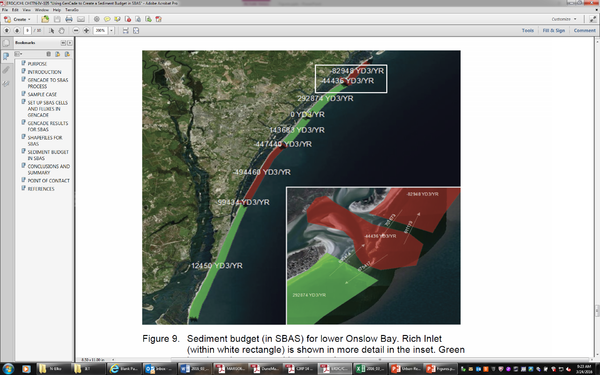
Ashley Frey provided an update on the Sediment Budget Analysis System (SBAS) and its integration with GenCade to the Coastal Working Group call in January, research that has been funded by the CIRP and Regional Sediment Management Programs. The presentation included background on SBAS and GenCade, reasons for the integration, and steps required to produce the desired GenCade output for SBAS. Edwin Sheldon, a contractor with the Mobile District and the SBAS developer, gave a demo showing how to use the newest version of SBAS in ArcGIS. For more information about GenCade connection, please see: http://cirp.usace.army.mil/products/gencade.php.
RSM Website: http://rsm.usace.army.mil
SBAS Desktop Tools: http://geoplatform.usace.army.mil/home/item.html?id=012c821cf7a84af8ae313d7fe4ac71f2
POC: Ashley Frey, Ashley.E.Frey@usace.army.mil
Research Advancements in Nearshore Berms
Sediment Mobility Tool
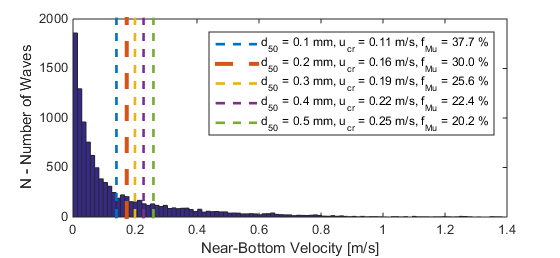
The Sediment Mobility Tool (SMT) developed by the CIRP Geomorphology Work Unit was applied to two nearshore placement sites for dredged material from Milford Harbor in Milford, CT. The tool predicts how often placed material will be mobilized and the direction of sediment transport. Results from the tool, with recommendations, were written in a letter report and submitted to NAE on November 20, 2015. The SMT has been applied at Duck, NC and Vilano Beach, FL, and is scheduled to be applied at Palm Beach, FL, Burns Harbor, IN, and Illinois Beach State Park, IL. The SMT is being developed into a web application and will be available at the end of FY16.
POC: (ERDC) Brian McFall, Brian.C.McFall@usace.army.mil
POC: (ERDC) Katie Brutsche, Katherine.E.Brutsche@usace.army.mil
Depth of Closure Database and Map
The depth of closure (DOC) has been calculated for several sediment grain sizes for the entire United States coastline using WIS hindcast stations. The DOC is a theoretical depth along a beach profile where sediment transport is very small or non-existent, dependent on wave height and period, and occasionally, sediment grain size. Equations derived by Hallermeier (1981) and Birkemeier (1985) were used to calculate DOC. Data are currently available in a database form, available on the CIRP website (http://cirp.usace.army.mil/products/depth-of-closure.php). In the future, the data will be available as a static map and included as part of a web application with the Sediment Mobility Tool (SMT), which will be available at the end of FY16.
POC: (ERDC) Katie Brutsche, Katherine.E.Brutsche@usace.army.mil
POC: (ERDC) Brian McFall, Brian.C.McFall@usace.army.mil
Implications of Vessel Draft Restrictions, Southwest Pass, LA
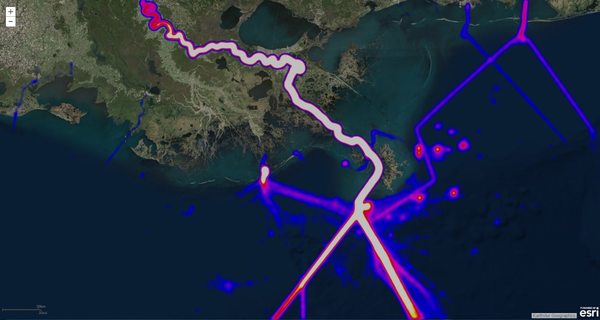
In February 2016, Dr. Ned Mitchell briefed the Mississippi Valley Division on tools and capabilities for estimating the economic impacts and disruptions to shipping from the recently-implemented vessel draft restrictions at Southwest Pass on the Lower Mississippi River, using two CIRP-supported tools. The Channel Portfolio Tool (CPT: https://cpt.usace.army.mil) was applied to access historic Waterborne Commerce records and analyze tonnage and vessel trends for the range of sailing drafts affected by the restrictions. These trends were then used to calculate additional shipping costs necessitated by the light-loaded vessels. The Automatic Identification System Analysis Portal (AISAP: http://ais-portal.usace.army.mil) was also applied to analyze recent disruptions to and adjustments by the shipping industry to the Southwest Pass Draft restrictions (Figure 6). Archived AIS position reports are retrieved from U.S. Coast Guard-maintained database servers to analyze net voyage counts in and out, dwell times in the various anchorages, and travel times. These tools are available: Channel Portfolio Tool (CPT: https://cpt.usace.army.mil) and Automatic Identification System Analysis Portal (AISAP: http://ais-portal.usace.army.mil).
POC: (ERDC) Kenneth (Ned) Mitchell, Kenneth.N.Mitchell@usace.army.mil
POC: (ERDC) Brandan Scully, Brandan.Scully@usace.army.mil
Research in Publication: Tidal Analysis and Arrival Process Mining Using Automatic Identification System (AIS) Data
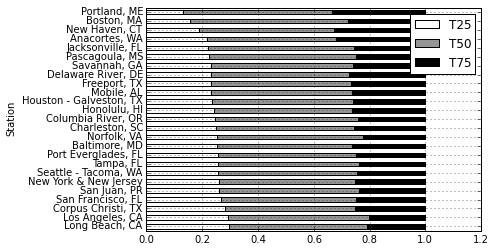
CIRP researchers evaluated the influence of tidal water level fluctuations for vessels arriving at 24 major port areas maintained by the USACE. The study determined the water level at the time of vessel arrival for 2012, 2013, and 2014, and estimated the proportion of vessel traffic arriving at port area entrances during periods of "high", "low", or "mid" tide (Figure 7). This is the first large-scale study of its kind and provides a method to compare vessel traffic at ports with varying tidal ranges and patterns. The foundational study provided insight into how vessels use fluctuating water depths to move through USACE navigation projects. The new technical report will be available by the end of FY16, and documents the analysis method and results and provides practical methods for determining vessel arrival patterns of interest to USACE practitioners at projects covered by AIS data.
POC: (ERDC) Brandan Scully, Brandan.Scully@usace.army.mil
POC: (ERDC) Patty DiJoseph, Patricia.K.DiJoseph@usace.army.mil
POC: (ERDC) Kenneth (Ned) Mitchell, Kenneth.N.Mitchell@usace.army.mil

Dr. Patricia DiJoseph was invited to present "Inland Waterways Resilience - Navigation Research Perspective" at a Transportation Research Board (TRB) panel session on "Commonsense Solutions for Cost-Effectively Combining Resilience and Port Operational Needs" in January 2016 in Washington, D.C. Dr. DiJoseph described how a statistical profile of waterway transit times can be a tool for understanding and improving resiliency of the marine transportation system (MTS), see Figure 8. In the underlying research project transit times are estimated from archival Automatic Identification System (AIS) vessel position data. While this research is under the NavSys Program, it utilized the AIS Analysis Package (AISAP), a tool that CIRP developed in collaboration with the NavSys Program, to query, visualize, and analyze the data. Specific applications include establishing baseline MTS performance levels, measuring system resiliency (ability to withstand and recover from events), and locating system bottlenecks and areas with most critical needs. These are being applied to both inland and coastal waterways.
POC: (ERDC) Patty DiJoseph, Patricia.K.DiJoseph@usace.army.mil
POC: (ERDC) Kenneth (Ned) Mitchell, Kenneth.N.Mitchell@usace.army.mil
POC: (ERDC) Brandan Scully, Brandan.Scully@usace.army.mil
Engineer Research & Development Center
3909 Halls Ferry Road, Coastal & Hydraulics Laboratory
Vicksburg, MS 39180
202-761-1850